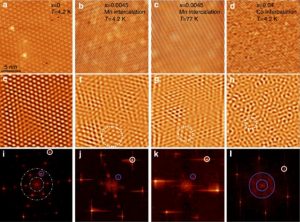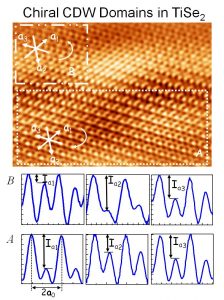Materials containing CDWs are ideal for exploring structural-symmetry-breaking induced by electron modulation and the intricate quantum phenomena that stem from the interplay of electron-phonon and electron-electron interactions.
Layered transition metal dichalcogenides (TMDs) have attracted interest in view of their rich phase diagrams with commensurate/incommensurate CDWs and superconductivity tunable by temperature, pressure, electric field or intercalation. Their quasi-2D characteristics also enable property control via thickness effects.
Emergence of coherence in the charge-density wave state of 2H-NbSe2

CDW STM topographic images of NbSe2 and intercaled NbSe2 single crystals.
Modern research techniques allow us to explore and control emergent behavior that arises from complex correlations using local real space probes (low temperature Scanning Probe Microscopy and Spectroscopy) and correlating them with k-space techniques such as ARPES and X-rays. We find that intercalation affects the CDW transition temperature but at the same time we observe a large portion of the phase diagram (T-intercalation %) in which short range order CDW correlations are present. This phase diagram closely resembles that of the transition from the superconducting to the pseudogap state in cuprates, and that of the superconducting to insulating transition in disordered systems.
Nature Communications 6, 6313 (2015)
https://www.anl.gov/article/unraveling-the-origin-of-the-pseudogap-in-a-charge-density-wave-compound
https://phys.org/news/2015-04-unraveling-pseudogap-density-compound.html
Chiral Charge Density Waves in TiSe2 and CuxTiSe2

STM topography of CDW in TiSe2 and line profiles along the unit vectors corresponding to the two regions with opposite chirality, showing that the intensity grows clockwise in one region and counterclockwise in the other.
The CDW in TiSe2 has been previously shown to exhibit a chiral order that sets in just below the thermodynamic CDW transition temperature (TCDW~200K) (Phys. Rev. Lett. 105, 176401 (2010), Phys. Rev. Lett. 110, 196404 (2013)) . The true bulk chiral state has been confirmed by reflectivity measurements to originate from the 1T-character of the crystal lattice, which lacks inversion symmetry. We have shown, using low temperature STM, that the chiral CDW exists in the form of chiral domains of opposite sign. Furthermore, TEM experiments with DFT modeling have shown that CDW phase in exfoliated single crystals of 1T-TiSe2 forms 3D cylinder shape domains, with short-range in- plane coherence and long-range out-of-plane coherence.
The use of collective chiral CDW states in electronic devices could extend the current down-scaling limit of complementary metal-oxide semiconductors, which is set by the level of power dissipation in incoherent electron based devices.
Phys. Rev. B 85, 155103 (2012)
Phys. Rev. Materials 1, 054002 (2017)
